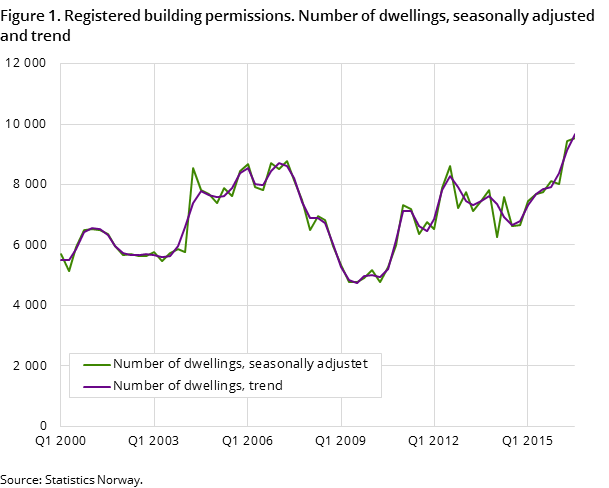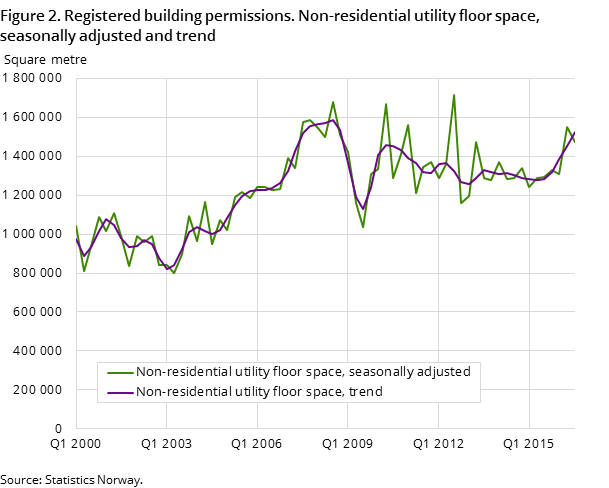Content
Published:
This is an archived release.
Small changes in new dwellings
One per cent more building start permits were given in the third quarter of 2016 compared with the second quarter of 2016, according to seasonally-adjusted figures.
| 3rd quarter 2016 | |||
|---|---|---|---|
| Seasonally adjusted | Unadjusted | ||
| Percentage change from the previous quarter | Percentage change from the same quarter previous year | Total | |
| Dwellings | 0.9 | 22.7 | 8 774 |
| Utility floor space, 1000 m2 | |||
| Dwellings | 2.6 | 12.8 | 1 102.6 |
| Other buildings | -4.9 | 13.9 | 1 397.5 |


Figures vary considerably from quarter to quarter. The long-term trend shows good growth in the number of building permits since the third quarter of 2014.
For non-residential buildings, seasonally-adjusted figures show that building start permits measured in utility floor space decreased by 5 per cent, from the second quarter to the third quarter this year.
8 800 new dwelling permits last quarter
In the third quarter of 2016, building start permits were given on 8 800 dwellings, with a total of about 1 103 000 square metres of utility floor space. New dwellings increased by 23 per cent compared with the third quarter of 2015.
The largest increase in building permits was for flats, which increased by 52 per cent compared with the third quarter of 2015. Building permits for detached houses did however decrease by 6 per cent in the same period.
Most permits in Oslo, Akershus and Hordaland county
The county of Oslo had the most dwelling start permits, with 1 296, followed by Akershus and Hordaland counties with 1 292 and 1 231 respectively.
Increase in industrial sector
In the third quarter of 2016, building start permits were given for about 976 000 square metres of utility floor space within the industrial sector. This is an increase of 9 per cent compared with the same quarter in 2015.
526 new dwellings in rebuilding projects
As of the third quarter 2016, figures are published for dwellings constructed by rebuilding existing buildings (i.e. new dwellings due to reconstruction of utility floor space from industry to dwellings). Quarterly and annual figures are published for 2012 and onwards in StatBank.
In the third quarter of 2016, the number of dwellings due to rebuilding projects increased by 526. Of these transformation dwellings, 195 were due to rebuilding of residential buildings, 287 were built in industrial buildings, and 44 were due to the rebuilding of garages, outhouses and annexes linked to dwellings, leisure homes etc.
524 demolished dwellings
In the third quarter of 2016, a total of 524 dwellings were demolished, of which 368 were detached houses. For buildings other than residential buildings, 943 buildings in the industrial sector were pulled down, and 301 holiday homes and 1 521 private garages were demolished.
Registered building permissionsOpen and readClose
Figures for buildings in the building statistics rely on dates for when permits are registered by the municipality in the data register (Matrikkelen). A building permit does not always mean that construction will be started at once. Especially in low conjunctures it might be that construction projects are not realised, or may be postponed after a building permit has been granted. When the building activity trend turns from a low to a high level, and vice versa, this could affect the interpretation of the statistics.
More details about comparability, quality and other information are available in About the statistics .
Contact
-
Jens Mathiesen
E-mail: jens.mathiesen@ssb.no
tel.: (+47) 40 81 13 98
-
Magnus Espeland
E-mail: magnus.espeland@ssb.no
tel.: (+47) 45 27 40 08
